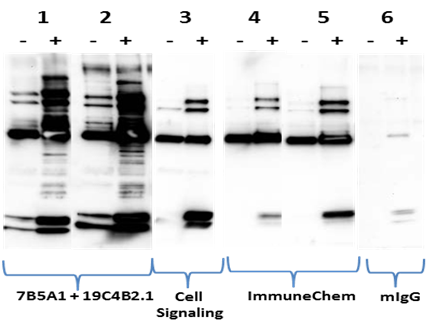Acetyl-Lysine Affinity Beads
As part of the Signal-Seeker™ product line, AAC04 acetyl-lysine affinity beads have been optimized to detect endogenous levels of lysine-acetylated proteins. Acetyl-lysine affinity beads comprise a proprietary mixture of two anti-acetyl lysine antibodies (Clones 7B5A1 and 10C4B2.1) that has been chemically conjugated to Protein G beads. Validation studies have shown that these beads can immunoprecipitate a wide range of lysine-acetylated proteins with minimal detectable leaching of either heavy or light chains in an IP assay. A comprehensive Signal-Seeker™ acetyl-lysine Detection Kit is also available (BK163) and is recommended for first time users.
Validation Data: Acetyl-Lysine Affinity Beads White Paper
Each lot of affinity-bead is quality controlled to provide high batch to batch consistency, see COA documents.
Validated Applications
Comparison of acetylated protein enrichment using various acetyl-lysine affinity beads.
AAC02, AAC03, and AAC04 acetyl lysine enrichment beads (50 μl bead slurry) were used to IP acetylated proteins from Cos-7 cells either treated (+) or untreated (-) with TSA (1 μM) and nicotinamide (1 mM) for 6 hours. The total profile of enriched acetylated proteins were eluted and analyzed by western blot with an AAC03-HRP antibody (1:3000).

Enrichment of acetyl-lysine proteins using AAC04 affinity beads, cell signaling acetyl lysine antibody, and immune chem acetyl lysine affinity beads
Figure 2. Various acetyl-lysine affinity reagents were used to IP acetylated proteins from Cos-7 cells either treated (+) or untreated (-) with TSA (1 μM) and nicotinamide (1 mM) for 6 hours. (1) 16.7 ml of AAC04 bead slurry (20 μg antibody). (2) 50ml of AAC04 bead slurry (60 μg antibody). (3) Anti-acetyl lysine rabbit monoclonal mix (Cell Signaling, 1:100 per manufacturer’s instruction). (4) ImmuneChem acetyl lysine affinity bead (40 μg antibody). (5) ImmunChem acetyl lysine bead (80 μg antibody). (6) Normal mouse IgG control bead (60 μg antibody). The total profile of enriched acetylated proteins were eluted and analyzed by western blot with an AAC03-HRP antibody (1:3000). AAC04 performed exceptionally well in enriching a broad range of acetylated proteins whereas the other commercial acetyl lysine enrichment reagents primarily enriched the most abundance acetylated proteins (e.g. acetylated tubulin and histones).

Immunoprecipitation of target specific acetylated proteins using AAC04 affinity beads
Figure 3A: A431 cells, untreated (-) or treated (+) with 1mM TSA and 1 μM nicotinamide for 6 hours, were isolated using BlastR buffer. IP was performed using AAC04 beads (60 μg). Total cell lysate (Input) and immunoprecipitated samples were separated by SDS-PAGE and analyzed by western blot with antibodies against EGFR (Millipore, 1:1000), Hsp90 (Abcam, 1:20,000), P53 (Sigma, 1:2000), and RhoDGI(Millipore,1:1000)
Immunoprecipitation of acetylated proteins from liver and heart tissue using AAC04 affinity beads
Figure 3B: Mouse tissue extracts (liver and heart) were obtained with BlastR buffer. IP was performed using AAC04 beads (60 μg) or mIgG control bead (#CIG02, 60 μg) in 1mg of tissue extracts. Enriched proteins were separated by SDS-PAGE and analyzed by western blot with AAC03-HRP (1:3000).

Amount:
Each package contains enough acetyl-lysine affinity beads for 40 reactions.
For more information contact: signalseeker@cytoskeleton.com
Associated Products:
Signal-Seeker™ SUMOylation 2/3 Detection Kit (Cat. # BK162)
Signal-Seeker™ Ubiquitination Detection Kit (Cat. # BK161)
Signal-Seeker™ Acetyl-Lysine Detection Kit (Cat. # BK163)
Signal-Seeker™: BlastR™ Rapid Lysate Prep Kit (Cat. # BLR01)
Signal-Seeker™: PTMtrue™ Aceetyl lysine Antibody (Cat.# AAC03)
For product Datasheets and MSDSs please click on the PDF links below.
Visit our Signal-Seeker™ Tech Tips and FAQs page for technical tips and frequently asked questions regarding this and other Signal-Seeker™ products click here
If you have any questions concerning this product, please contact our Technical Service department at tservice@cytoskeleton.com








